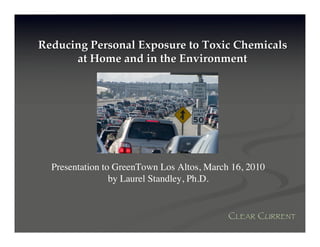
Los Altos Presentation March2010
- 1. Reducing Personal Exposure to Toxic Chemicals at Home and in the Environment Presentation to GreenTown Los Altos, March 16, 2010 by Laurel Standley, Ph.D. CLEAR CURRENT
- 2. Overview: Exposure to Toxic Substances •What are we exposed to? •new and old environmental contaminants •ingredients and byproducts •Why reduce exposure? •associations with disease •Where do the exposures come from? •food, consumer products, environment •How to reduce your exposure? CLEAR CURRENT
- 3. What are we exposed to? Human monitoring: •CDC 3rd report (148 chemicals) •EWG reports Body Burden & umbilical cord data >200 chemicals •News organizations Toxic chemicals detected in blood, fat, breast milk and/or urine: •Heavy metals: lead, mercury, cadmium •Polychlorinated biphenyls (PCBs) •Polychlorinated dioxins and furans •Polycyclic aromatic hydrocarbons (PAHs) •Pesticides: ‘legacy’ - DDT/DDE, new - organophosphate •Plasticizers: phthalates, bisphenol A (BPA) •Perfluorinated chemicals - ‘non-stick’ •Flame retardants: polybrominated diphenyl ethers (PBDEs) CLEAR CURRENT
- 4. Diseases Associated With Environmental and Household Toxic Exposures Strength of evidence: •human studies with controls (no exposure) •large numbers •animal studies demonstrating link between exposure and disease Strongest associations: •smoking - heart/lung disease •accidental or occupational exposure - Minamata disease (Hg), microwave popcorn and impaired lung function Epidemiological: •higher disinfection byproducts in drinking water and bladder cancer CLEAR CURRENT
- 5. Cancer Bladder cancer: •disinfection byproducts •older dark hair dyes Breast cancer: •xenoestrogens •light at night Leukemia: children of women exposed to pesticides during pregnancy Pancreatic: pesticide use Timing: DDT exposure before age 15 elevates risk of breast cancer risk more than later exposures Gene-environment interactions: PAH exposure + genetic predisposition to breast cancer much greater risk than either alone CLEAR CURRENT
- 6. Reproduction and Development Decreasing sperm count: •U.S. and Europe 50% lower than men born in pre- synthetic chemical era (World War II) •China 60% lower than 1980s Shorter anogenital index (AGI): associated with mother’s phthalate exposure. (Swan 2005) CLEAR CURRENT
- 7. Reproduction & Development, cont. Neurological development: mercury, lead Low birth weight: air pollution Lower boy to girl birth ratio: PCBs, dioxin Birth defects: pesticides, phthalates Longer time to pregnancy: perfluorochemicals Gynecomastia (breast development in boys): lavender and tea tree oil CLEAR CURRENT
- 8. Heart Disease and Stroke Air pollution: Harvard Six Cities Study Cities that reduced air pollution documented lower levels of pollution-related mortality (heart disease and stroke) than those that did not. CLEAR CURRENT
- 9. Asthma Plasticizers: vinyl (shower curtains, toys) Harsh household cleaners: bleach and ammonia Air pollution: Atlanta Olympics study CLEAR CURRENT
- 10. Lowering Your Body Burden of Toxic Chemicals Residence time in your body: •Hours to days •phthalates, bisphenol-A, mercury, OP pesticides •Years •‘non-stick’ fluorinated chemicals, flame retardants •Decades •DDT/DDE, PCBs, dioxins Intervention studies critical but rare CLEAR CURRENT
- 11. Food Web: Bioaccumulation Fat soluble contaminants accumulate through the food web, thousands to millions times more concentrated at the top of the food web CLEAR CURRENT
- 12. Sources of Contaminants in Food Accumulated by animals: •Air pollution •Pesticides in grass/food Pesticides used during farming/transport Food packaging/storage/preparation: •Phthalates: tubing/plastic wrap •BPA: polycarbonate/can liners •Pans: nonstick/perfluorinated •Fast food wrappers, grease-proof CLEAR CURRENT
- 13. Organic vs Conventional Diet (Lu et al. 2005) CLEAR CURRENT
- 14. Personal Care and Household Products Ingredients to avoid/minimize use of: •Antimicrobials: triclosan/triclocarban/microban •Fragrances •Petroleum-based vs bio-based •Parabens Many, if not most ingredients labels incomplete Selecting safer products: www.GoodGuide.com and www.CosmeticsDatabase.com CLEAR CURRENT
- 15. Consumer Products: Phthalates (Duty et al. 2005) CLEAR CURRENT
- 16. ‘Safer’ Plastics CLEAR CURRENT
- 17. Consumer Products: ‘Non-Stick’ PFCs Sources to food: •Fast food packaging •Non-stick pans •Microwave popcorn bags Household sources: •Stain-resistant carpets/furniture •Waterproof fabrics •Ski-wax CLEAR CURRENT
- 18. Consumer Products: Flame Retardants Household sources: •Electronics •Furniture, mattresses •Carpet pads •Clothing CA regulations = 2x body burdens (Zota et al. 2008) CLEAR CURRENT
- 19. Combustion: PAHs & Other Chemicals Whatever you burn or ignite, creates toxic gases, PAHs, and particles: •Gas appliances •Wood stoves or fireplaces •Candles: soy/beeswax < paraffin < incense Including food: •Barbecue •Charred toast Heat sources: natural gas < petroleum < wood smoke CLEAR CURRENT
- 20. Environment: Air Pollution Sources: •Diesel exhaust particularly toxic •Proximity of major highways •Shift time of your commute/exercise •Enact ordinances to reduce truck idling Improving indoor air quality: •House plants •HEPA/carbon filters (vacuum, heater) •Vent: garage, all gas appliances CLEAR CURRENT
- 21. Environment: Water Water contaminants: •Lead Solution: filtration •Pharmaceuticals - depends on contaminants •Pesticides but best general home •Nitrates treatment is carbon block •Volatile Organics filter •Disinfection byproducts (DBPs) DBPs also in: •Swimming pools •Shower spray CLEAR CURRENT
- 22. Bottom Line: What Can You Control? What we know << what we don’t know •>100,000 chemicals in commerce •EPA estimates we are exposed to ~6,000 •Only 200 tested for health issues Differences in body burdens = opportunity Consumer pressure Regulation •TSCA vs REACH •CA Prop 65 and Green Chemistry Initiative CLEAR CURRENT
- 23. Resources Websites: •GoodGuide •Environmental Working Group •Cosmetics Database Daniel Marsula Pittsburgh Post Gazette •NRDC •National Geographic Green Guide Download ‘Twelve Tips for Reducing Personal Exposure’: www.clear-current.com/publications.html Support the Household Intervention Study: www.SilentSpring.org/support-our-work CLEAR CURRENT